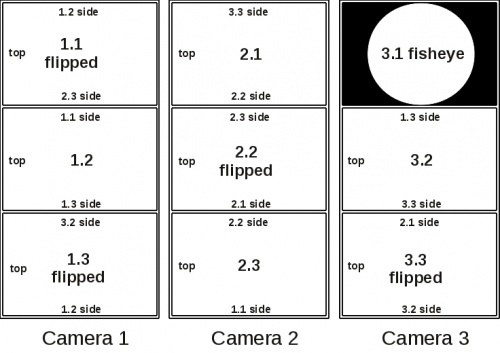Difference between revisions of "Eyesis workflow"
From ElphelWiki
| Line 20: | Line 20: | ||
==Workflow== | ==Workflow== | ||
| − | |||
| − | + | ==== GUI (Eyesis operating, installed on the laptop used for controlling the camera)==== | |
| − | * | + | * [http://wiki.elphel.com/index.php?title=Eyesis_gui elphel-eyesis-gui] - camera GUI |
| − | * [http://www.cybercom.net/~dcoffin/dcraw/ Dcraw] | + | ==== Elphel Eyesis SDK software (pre-installed, post-processing)==== |
| + | |||
| + | * [http://wiki.elphel.com/index.php?title=Movie2dng Movie2DNG] - extracting JP4 (JP4 is the Elphel raw image format) images from *.MOVs. | ||
| + | * [http://rsbweb.nih.gov/ij/ ImageJ] - ImageJ with Elphel plugins (image quality enhancement, color balance) for processing JP4s -> TIFF/JPEG output. | ||
| + | * [http://hugin.sourceforge.net/ Hugin tools] (with Elphel PHP scripts for automatic work) - stitching | ||
| + | * [http://www.imagemagick.org/script/index.php ImageMagick] (also with a simple PHP script) - converting/modifying panorama JPEGs - scaling for WebGL. | ||
| + | * other pre-installed PHP scripts: | ||
| + | ** exif2kml.php - extract the GPS data from images and put it all to a KML file of the route. | ||
| + | ** create_links_xml_file.php - read the KML file and create file with records-links of the route points. Is used in [http://eyesisbox.elphel.net/webgl-pano/geo_tests.html Elphel WebGL Viewer] | ||
| + | |||
| + | other: | ||
| + | * [http://ufraw.sourceforge.net/ Ufraw] - view/process DNG/TIFF | ||
| + | * [http://www.cybercom.net/~dcoffin/dcraw/ Dcraw] - converting JPEGs | ||
| + | |||
| + | |||
| + | |||
| + | ==== Processing panorama possible steps==== | ||
| + | |||
| + | * A stitching template *.pto should be created in [http://hugin.sourceforge.net/ Hugin] (created once and reused later). Elphel is providing a sample template with the camera (individual for each). | ||
| + | |||
| + | * Copy all the *.mov files to certain locations (folders must have the r/w rights enabled for everyone): | ||
| + | Currently: | ||
| + | hdd1: /data/disk/<footage_name>/ | ||
| + | hdd2: /data/disk-1/<footage_name>/ | ||
| + | hdd3: /data/disk-2/<footage_name>/ | ||
| + | |||
| + | * '''<nowiki>http://127.0.0.1/scripts/split_mov.php?dir=<footage_name></nowiki>''' - (usage TBA) - it applies [http://wiki.elphel.com/index.php?title=Movie2dng Movie2DNG] to all the footage files. The output is JP4 files. | ||
| + | * '''<nowiki>http://127.0.0.1/scripts/exif2kml.php?dir=<footage_name></nowiki>''' - it extracts the GPS data from images and put it all to a KML file of the route. The output is a KML file. | ||
| + | * Launch [http://rsbweb.nih.gov/ij/ ImageJ] and process the files. The output is JPEGs (optionally, TIFF). (This step can be skipped, but some other converting to JPEGs is required then - movie2dng+dcraw, for an instance). | ||
| + | * '''<nowiki>http://127.0.0.1/scripts/stitch.php?dir=<dir_name></nowiki>''' - stitches the images processed ImageJ using [http://hugin.sourceforge.net/ Hugin tools]. | ||
| + | * '''<nowiki>http://127.0.0.1/scripts/convert_images_for_webgl.php?dir=<results_dir></nowiki>''' - rescale results using [http://www.imagemagick.org/script/index.php ImageMagick]. | ||
Revision as of 11:19, 2 May 2011
Contents
Preface
The following page describes the Eyesis camera post-processing procedures.
Eyesis Output
- 3x HDDs, each containing *.mov files from 3x 3-sensor modules (a single HDD is connected to an individual camera module).
- Each frame in a *.mov file is a combination of frames from 3 sensors glued vertically - triplet.
- The modules are numbered - 1,2,3 - having individual ip address:
192.168.0.221 192.168.0.222 192.168.0.223
- The sub images are [1.1, 1.2, 1.3], [2.1, 2.2, 2.3], [3.1, 3.2, 3.3]. 3.1 is the fisheye image.
- The frames in *.movs are indexed.
- A single image format is JP4 (a raw format with a higher quality and frame rate against *.jpeg).
- Corresponding frames have the same time stamps generated by the 1st camera.
- The 1st camera frames are geotagged.
Post-Processing Setup
- HDDs are put into a processing PC and the data is copied.
Workflow
GUI (Eyesis operating, installed on the laptop used for controlling the camera)
- elphel-eyesis-gui - camera GUI
Elphel Eyesis SDK software (pre-installed, post-processing)
- Movie2DNG - extracting JP4 (JP4 is the Elphel raw image format) images from *.MOVs.
- ImageJ - ImageJ with Elphel plugins (image quality enhancement, color balance) for processing JP4s -> TIFF/JPEG output.
- Hugin tools (with Elphel PHP scripts for automatic work) - stitching
- ImageMagick (also with a simple PHP script) - converting/modifying panorama JPEGs - scaling for WebGL.
- other pre-installed PHP scripts:
- exif2kml.php - extract the GPS data from images and put it all to a KML file of the route.
- create_links_xml_file.php - read the KML file and create file with records-links of the route points. Is used in Elphel WebGL Viewer
other:
Processing panorama possible steps
- A stitching template *.pto should be created in Hugin (created once and reused later). Elphel is providing a sample template with the camera (individual for each).
- Copy all the *.mov files to certain locations (folders must have the r/w rights enabled for everyone):
Currently: hdd1: /data/disk/<footage_name>/ hdd2: /data/disk-1/<footage_name>/ hdd3: /data/disk-2/<footage_name>/
- http://127.0.0.1/scripts/split_mov.php?dir=<footage_name> - (usage TBA) - it applies Movie2DNG to all the footage files. The output is JP4 files.
- http://127.0.0.1/scripts/exif2kml.php?dir=<footage_name> - it extracts the GPS data from images and put it all to a KML file of the route. The output is a KML file.
- Launch ImageJ and process the files. The output is JPEGs (optionally, TIFF). (This step can be skipped, but some other converting to JPEGs is required then - movie2dng+dcraw, for an instance).
- http://127.0.0.1/scripts/stitch.php?dir=<dir_name> - stitches the images processed ImageJ using Hugin tools.
- http://127.0.0.1/scripts/convert_images_for_webgl.php?dir=<results_dir> - rescale results using ImageMagick.
